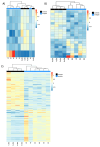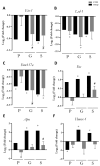Influence of Dietary Fiber and Polyphenols During Pre-Gestation, Gestation, or Lactation on Intestinal Gene Expression
- PMID: 39861471
- PMCID: PMC11767784
- DOI: 10.3390/nu17020341
Influence of Dietary Fiber and Polyphenols During Pre-Gestation, Gestation, or Lactation on Intestinal Gene Expression
Abstract
Background/objectives: Diet composition is important for health, especially during critical periods such as pre-gestation (P), gestation (G), or lactation (S), due to its potential impact not only on the mother but on the offspring. The Mediterranean diet includes many healthy foods rich in fiber and/or polyphenols, such as whole grains, fruits, vegetables, beans, and nuts. The present preclinical study assesses the impact of a diet rich in fiber and polyphenols (HFP diet) during one of those three periods (P, G, or S, three weeks each) on the rat gene expression of the small intestine obtained at the end of the lactation period.
Methods: This analysis was performed by the mRNA two step PCR amplification by random primers and poly-T, followed by library generation and HiSeq X-Ten Illumina sequencing (Seqplexing), and further confirmed by Real time PCR and ELISA.
Results: The results showed a broad number of genes significantly modulated after the HFP diet compared to the reference diet, with a higher number of genes modulated when the supplementing period was closer to the analysis day (S > G > P). Notably, genes involved in immune signaling, intestinal absorption, and cell growth were among those more significantly affected by the HFP dietary intervention. The HFP diet influenced the expression of key genes such as ferritin, fatty acid synthase, apelin, and complement proteins, among others. There was a unique gene modified in all the intervention periods (Family with Sequence Similarity 117 Member A, Fam117A, which codifies a protein with unknown function), indicating that this molecule may participate critically in the effects induced by fiber and polyphenols during these periods.
Conclusions: Overall, in rats, the influence of diet for a three-week period around birth is able to modulate the intestinal gene expression, and consequently, maternal health, which can eventually have an indirect impact on the offspring.
Keywords: Mediterranean diet; fiber; gene expression; gut; maternal diet; polyphenols; small intestine.
Conflict of interest statement
The authors declare that they have no conflicts of interest.
Figures




Similar articles
-
Cocoa polyphenols and fiber modify colonic gene expression in rats.Eur J Nutr. 2017 Aug;56(5):1871-1885. doi: 10.1007/s00394-016-1230-0. Epub 2016 Jun 2. Eur J Nutr. 2017. PMID: 27256297 Free PMC article.
-
Maternal high-protein or high-prebiotic-fiber diets affect maternal milk composition and gut microbiota in rat dams and their offspring.Obesity (Silver Spring). 2014 Nov;22(11):2344-51. doi: 10.1002/oby.20849. Epub 2014 Jul 24. Obesity (Silver Spring). 2014. PMID: 25056822
-
Effect of protein source in diets fed during gestation and lactation on food intake regulation in male offspring of Wistar rats.Am J Physiol Regul Integr Comp Physiol. 2011 May;300(5):R1175-84. doi: 10.1152/ajpregu.00744.2010. Epub 2011 Feb 16. Am J Physiol Regul Integr Comp Physiol. 2011. PMID: 21325647
-
The Role of Avocados in Maternal Diets during the Periconceptional Period, Pregnancy, and Lactation.Nutrients. 2016 May 21;8(5):313. doi: 10.3390/nu8050313. Nutrients. 2016. PMID: 27213449 Free PMC article. Review.
-
Potential of dietary polyphenols for protection from age-related decline and neurodegeneration: a role for gut microbiota?Nutr Neurosci. 2024 Sep;27(9):1058-1076. doi: 10.1080/1028415X.2023.2298098. Epub 2024 Jan 29. Nutr Neurosci. 2024. PMID: 38287652 Review.
References
MeSH terms
Substances
Grants and funding
LinkOut - more resources
Full Text Sources
Medical

